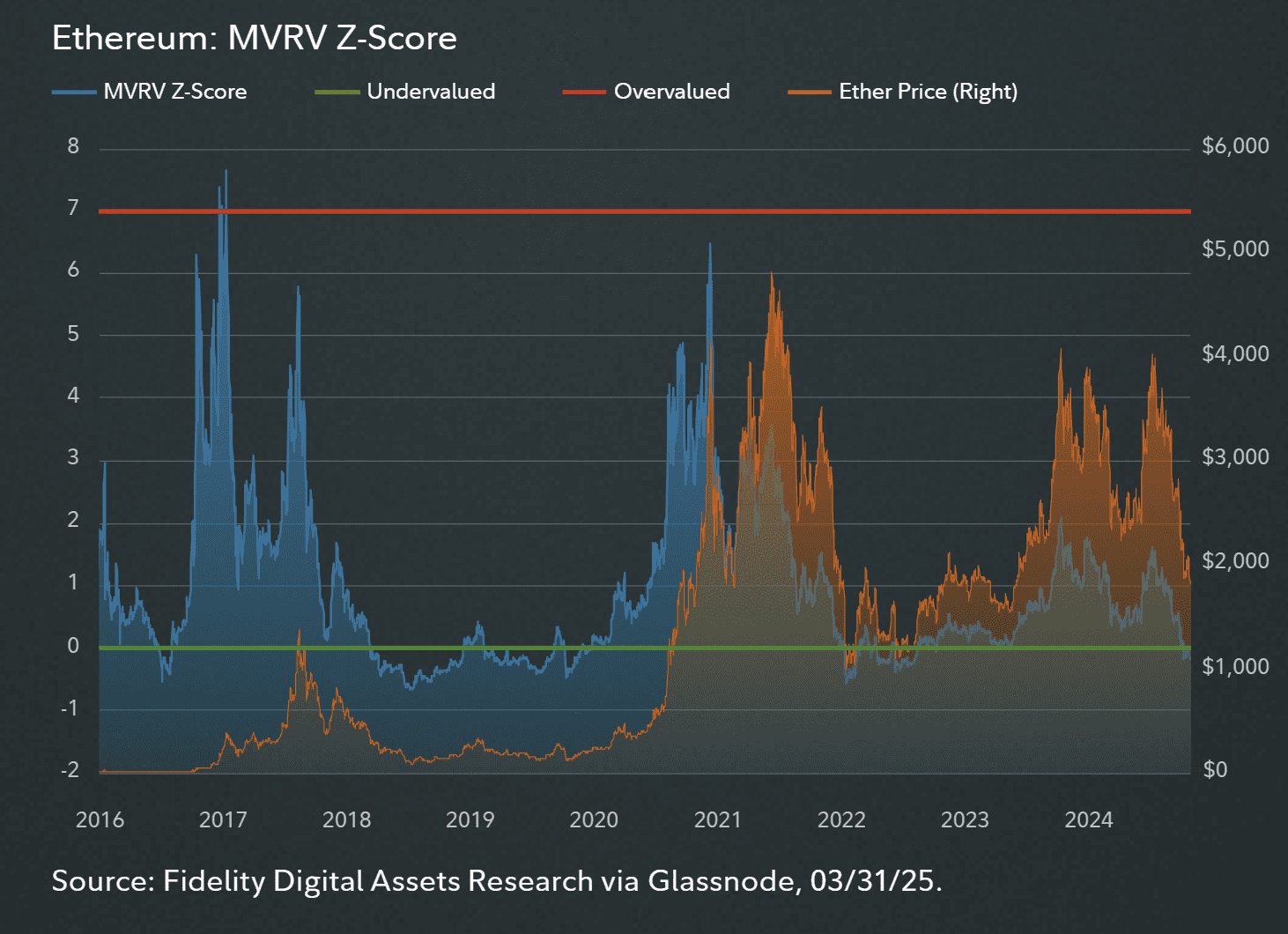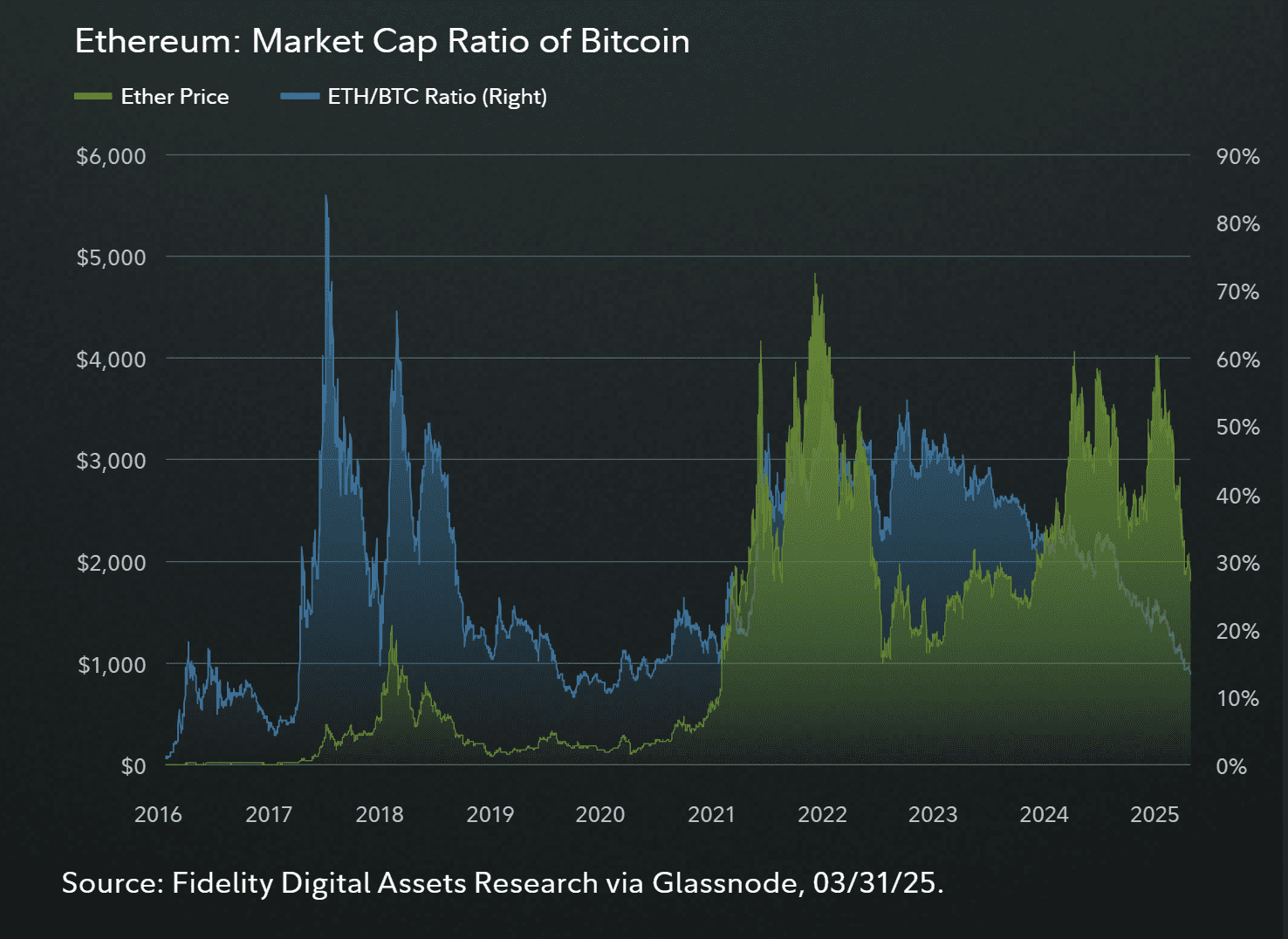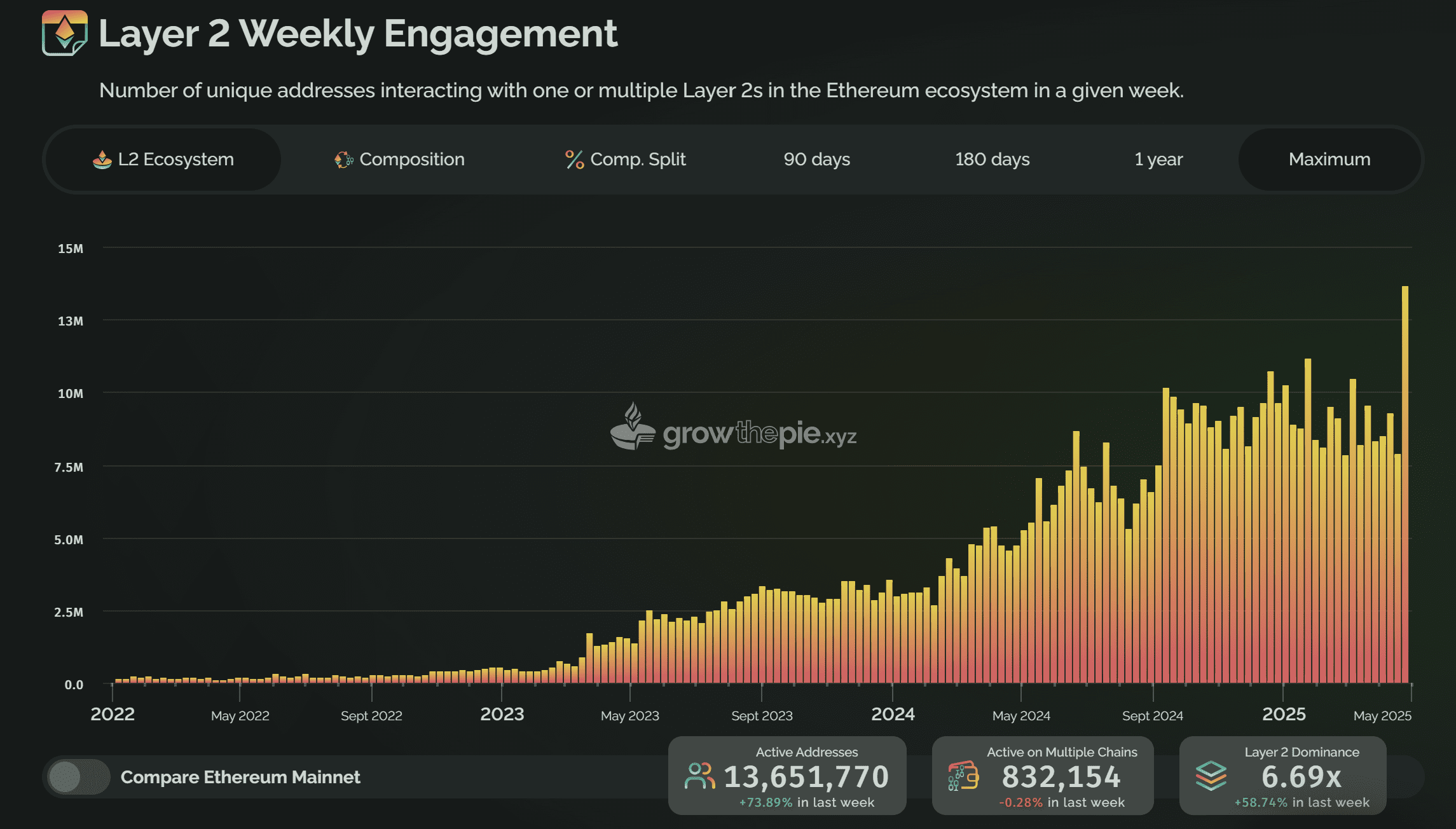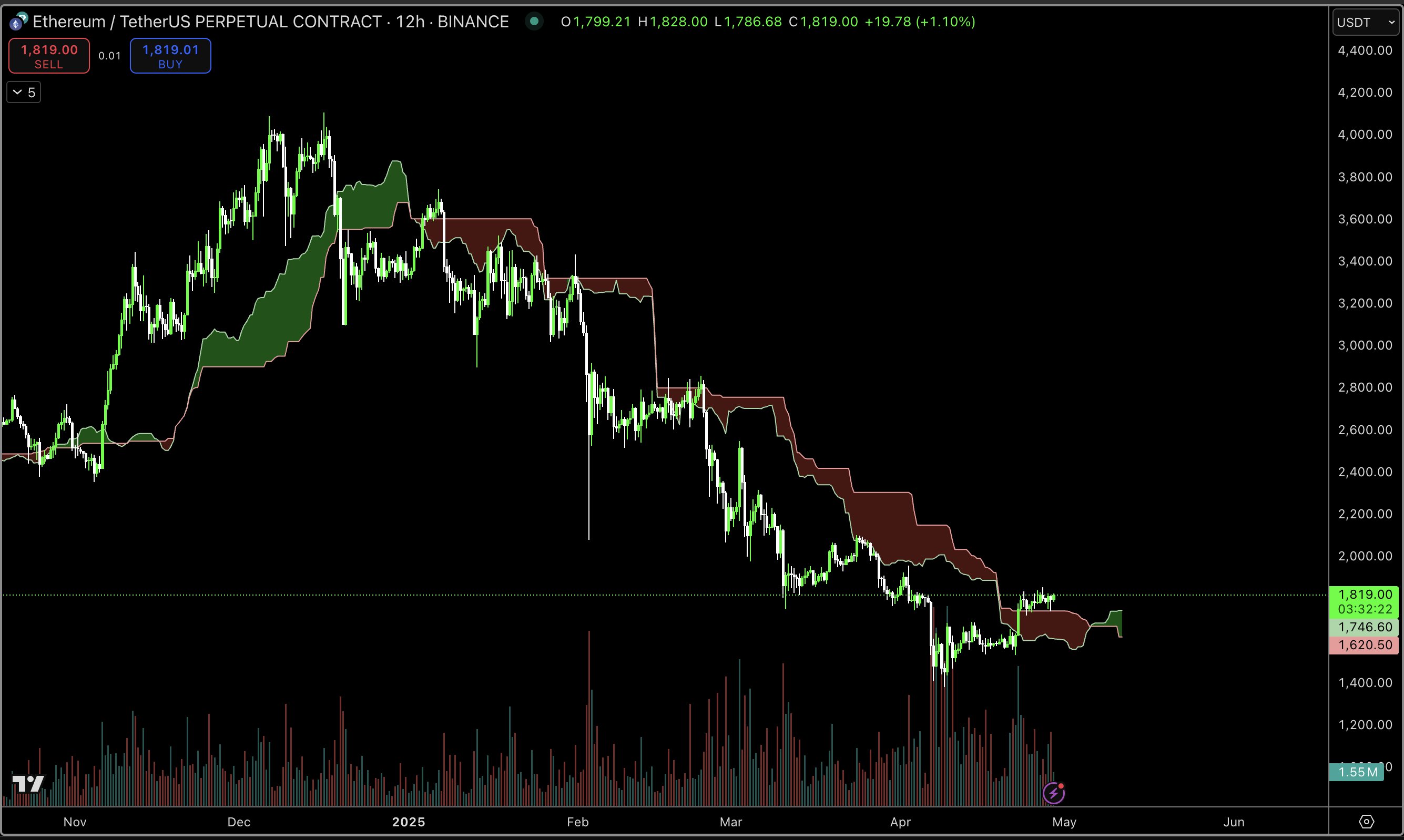Is Ethereum (ETH) poised for a turnaround? A recent report by Fidelity Digital Assets indicates that ETH might be trading at a discount, presenting a potential buying opportunity for investors. This assessment is based on several on-chain metrics that suggest ETH’s recent performance doesn’t reflect its underlying value.
Key Indicators Pointing to Ethereum’s Undervaluation
- MVRV Z-Score: The Market Value to Realized Value Z-Score, a metric comparing market value to realized value, dropped to -0.18, entering the “undervalued” zone. Historically, such levels have signaled market bottoms, suggesting ETH is “cheap” compared to its fair value.
- Net Unrealized Profit/Loss (NUPL): The NUPL ratio fell to 0, indicating “capitulation,” where unrealized profits equal losses, representing a neutral position for holders. This suggests that much of the speculative fervor has been washed out of the market.
- BTC/ETH Market Cap Ratio: The ratio sits at levels last seen in mid-2020, indicating that Ethereum’s market cap relative to Bitcoin is low. This suggests potential for ETH to catch up.
- Layer-2 Engagement: Active addresses on Ethereum’s layer-2 networks have hit new highs, reaching 13.6 million. This demonstrates growing adoption and scalability of the Ethereum ecosystem, suggesting increased utility and demand for ETH.

Diving Deeper: What the Metrics Mean
MVRV Z-Score Explained
The MVRV Z-Score is a critical metric for assessing whether an asset is overvalued or undervalued. It compares the market capitalization of an asset (the total value of all coins in circulation) to its realized capitalization (the sum of the value of all coins when they last moved on the blockchain). A low MVRV Z-Score suggests that the asset is trading below its realized value, indicating undervaluation. The Fidelity report’s observation that the MVRV Z-Score for ETH has entered the “undervalued” zone is a significant indicator that now might be an opportune time to invest.
NUPL and Market Sentiment
The Net Unrealized Profit/Loss (NUPL) ratio provides insights into the overall profitability of Ethereum holders. When NUPL is high, it signifies that a large portion of holders are in profit, which can lead to increased selling pressure. Conversely, when NUPL is low, it indicates that many holders are at a loss, potentially leading to a reduction in selling pressure and a possible market bottom. An NUPL of 0, as highlighted in the report, suggests that the market has reached a state of equilibrium where unrealized profits equal losses, indicating a potential stabilization point.
Ethereum’s Layer-2 Ecosystem Growth
Ethereum’s scalability issues have been a persistent challenge, but the rise of layer-2 networks has provided a viable solution. Layer-2 networks are built on top of Ethereum and handle transactions off-chain, reducing congestion and improving transaction speeds. The significant increase in active addresses on these networks, as noted in the Fidelity report, is a testament to the growing adoption and utility of Ethereum. This increased engagement suggests that more users are finding practical applications for ETH, which could drive demand and support its price.

Analyzing the ETH/BTC Market Cap Ratio
Fidelity’s report also highlights the Ethereum/Bitcoin market cap ratio, which is currently at mid-2020 levels. This metric compares the market capitalization of Ethereum to that of Bitcoin, providing insights into their relative performance. A low ETH/BTC ratio suggests that Ethereum is undervalued compared to Bitcoin, potentially indicating an opportunity for ETH to outperform BTC in the future. Several factors can influence this ratio, including technological advancements, regulatory developments, and overall market sentiment.
The Potential Upside and Risks
While the Fidelity report paints a cautiously optimistic picture for Ethereum, it’s essential to consider both the potential upside and the risks involved. The report’s analysis suggests that ETH may be undervalued, but the cryptocurrency market is inherently volatile and subject to various factors that can influence prices.
Potential Upside:
- Price Correction: If the market recognizes Ethereum’s undervaluation, a price correction could occur, leading to significant gains for investors.
- Continued Layer-2 Growth: The continued adoption and development of layer-2 networks could drive increased demand for ETH.
- Ethereum 2.0 Developments: Further progress on Ethereum 2.0, including the shift to Proof-of-Stake, could improve the network’s efficiency and scalability, attracting more users and investors.
Potential Risks:
- Market Volatility: The cryptocurrency market is known for its volatility, and Ethereum’s price could be subject to sudden and significant fluctuations.
- Regulatory Uncertainty: Regulatory developments could impact the cryptocurrency market, including Ethereum, and influence investor sentiment.
- Competition: Ethereum faces competition from other blockchain platforms, such as Solana and Cardano, which could affect its market share and price.

Ethereum’s Layer-2 Dominance
Growthepie.xyz data indicates that the number of unique addresses interacting with Ethereum layer-2 networks reached a new all-time high of 13.6 million, up 74% in a week. This highlights the network’s growing scalability and adoption. Unichain, a layer-2 protocol by Uniswap, led the charge with over 5.82 million weekly active addresses, surpassing Base and Arbitrum, improving Ethereum’s layer-2 dominance by 58.74% in the past week.

Conclusion
The Fidelity Digital Assets report offers valuable insights into the potential undervaluation of Ethereum. The MVRV Z-Score, NUPL ratio, and Ethereum/Bitcoin market cap ratio all suggest that ETH may be trading at a discount. The report also notes the increasing engagement with Ethereum’s layer-2 networks, indicating growing adoption and scalability. However, investors should carefully consider the potential risks and conduct their own research before making any investment decisions.